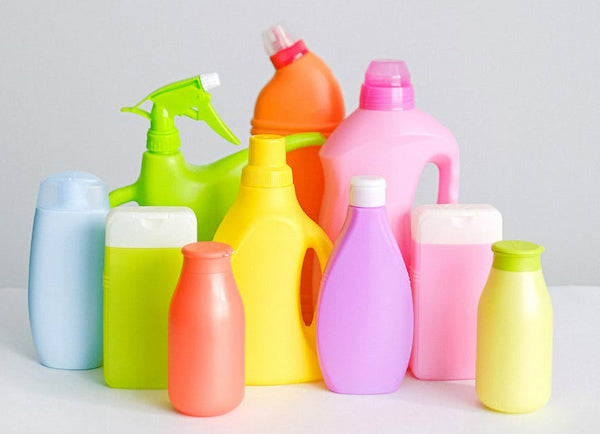When we buy cleaning products, we usually only pay attention to whether they clean properly. However, it is certain that most of the products available for purchase are completely suitable for this. However, we are not really aware of how these products harm our health. Therefore, it is especially important to know what the products we buy consist of. CYCLE will now help you with this: we will show you what to look for when choosing!
Reading time 5 minutes
Which toxic compounds are most common in cleaning products?
Toxic ingredients can be found in many household products, so it's good to know what to look for on labels. Let's get to know some of these substances and where they can be found:

Phthalates. This chemical can be found in scented household products, dish soap, air fresheners, and even scented toilet paper. Many products don’t list it on their labels, but if you see “scented,” it probably contains phthalates. Except for natural fragrances, of course, which we’ll cover in a separate post.
Perchloroethylene. Most commonly found in dry cleaning solutions, upholstery and carpet cleaners, and stain removers. Toxic, should not be inhaled.
Triclosan. If you come across a dishwashing detergent or soap labeled “antibacterial,” it likely contains the otherwise dangerous triclosan.
Quaternary ammonium compounds. Substances found in fabric softeners or antibacterial household cleaners. Toxic if swallowed, may cause asthma if inhaled.
2-Butoxyethanol. A regular ingredient in kitchen cleaners, window cleaners and multi-purpose cleaners, it can cause respiratory problems and asthma.
Ammonia. A common surface cleaning additive in bathroom cleaners and window cleaners. It is also harmful to inhale in large quantities.
Chlorine. Due to its strong disinfectant effect, it is found in many products. Even tap water contains small amounts.
Why are they dangerous?
There are several reasons why these chemicals used in cleaning products can be dangerous to our health:
They can disrupt our endocrine system. Phthalates can be absorbed through the skin and enter our bodies. Triclosan can also disrupt the endocrine system, and chlorine can have a negative impact on thyroid function (among other things).
They reduce fertility. Research shows that higher concentrations of phthalates in the blood result in a decrease in sperm count.
They can cause dizziness and loss of coordination. Perchloroethylene is a neurotoxin that we can breathe in. One of the consequences is loss of coordination or dizziness.
They may be carcinogenic. Some of the chemicals listed, such as triclosan, may have carcinogenic properties.
They can promote the emergence of superbugs. Antibacterial chemicals such as triclosan or quaternary ammonium compounds can promote the emergence of superbugs that are resistant to most antibiotics.
They can cause skin irritation. Contact with quaternary ammonium compounds can cause skin problems.
Can lead to respiratory problems. Inhaling certain chemicals, such as quaternary ammonium compounds or ammonia, can cause respiratory problems and contribute to the development of asthma.
They can cause a sore throat. Baking soda and 2-butoxyethanol can cause a sore throat due to their corrosive effects.
They can cause serious kidney and liver damage. Research has shown that 2-butoxyethanol can cause damage to our vital organs, especially if inhaled in high concentrations for a long time, for example in a poorly ventilated room.
Can cause burns. Highly alkaline chemicals (such as baking soda) can cause burns if exposed to high levels.
Does the label help us?
The purpose of the labels on cleaning products is to help you navigate the maze of chemicals. But it's not that simple.

List of ingredients. We can find the ingredients on the label, but unfortunately their names may differ. For example, we may find an anionic surfactant or a simple fragrance on the list, which does not help us to find out exactly what this ingredient is. The manufacturer's customer service can help with this, or we should immediately choose a product that we know for sure consists of non-toxic ingredients.
Hazard pictograms and warnings. We may not know all of the ingredients, but the hazard pictograms and warning labels should be clear to everyone. It is very important to never mix different cleaning agents and disinfectants. It is mandatory to indicate on the products if:
- irritating
- dangerous for the environment
- may damage the eyes
- corrosive to skin or eyes
- combustible
The label usually also indicates how to handle the resulting waste, as well as suggestions for proper storage.
Is there another solution?
We have good news! There is another solution if you want to clean your home with a cleaning product that does not contain dangerous chemicals.
CYCLE, a completely natural cleaning agent, does not contain any of the toxic substances listed above, does not harm the environment or our health, and in addition, we also reduce our ecological footprint.




